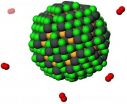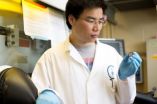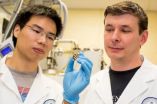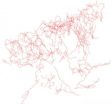(Press-News.org) TORONTO, ON — Think those flat, glassy solar panels on your neighbour's roof are the pinnacle of solar technology? Think again.
Researchers in the University of Toronto's Edward S. Rogers Sr. Department of Electrical & Computer Engineering have designed and tested a new class of solar-sensitive nanoparticle that outshines the current state of the art employing this new class of technology.
This new form of solid, stable light-sensitive nanoparticles, called colloidal quantum dots, could lead to cheaper and more flexible solar cells, as well as better gas sensors, infrared lasers, infrared light emitting diodes and more. The work, led by post-doctoral researcher Zhijun Ning and Professor Ted Sargent, was published this week in Nature Materials.
Collecting sunlight using these tiny colloidal quantum dots depends on two types of semiconductors: n-type, which are rich in electrons; and p-type, which are poor in electrons. The problem? When exposed to the air, n-type materials bind to oxygen atoms, give up their electrons, and turn into p-type. Ning and colleagues modelled and demonstrated a new colloidal quantum dot n-type material that does not bind oxygen when exposed to air.
Maintaining stable n- and p-type layers simultaneously not only boosts the efficiency of light absorption, it opens up a world of new optoelectronic devices that capitalize on the best properties of both light and electricity. For the average person, this means more sophisticated weather satellites, remote controllers, satellite communication, or pollution detectors.
"This is a material innovation, that's the first part, and with this new material we can build new device structures," said Ning. "Iodide is almost a perfect ligand for these quantum solar cells with both high efficiency and air stability—no one has shown that before."
Ning's new hybrid n- and p-type material achieved solar power conversion efficiency up to eight per cent—among the best results reported to date.
But improved performance is just a start for this new quantum-dot-based solar cell architecture. The powerful little dots could be mixed into inks and painted or printed onto thin, flexible surfaces, such as roofing shingles, dramatically lowering the cost and accessibility of solar power for millions of people.
"The field of colloidal quantum dot photovoltaics requires continued improvement in absolute performance, or power conversion efficiency," said Sargent. "The field has moved fast, and keeps moving fast, but we need to work toward bringing performance to commercially compelling levels."
INFORMATION:
This research was conducted in collaboration with Dalhousie University, King Abdullah University of Science and Technology and Huazhong University of Science and Technology.
Media contact:
Marit Mitchell
Senior Communications Officer
The Edward S. Rogers Sr. Department of Electrical & Computer Engineering
University of Toronto
416-978-7997; marit.mitchell@utoronto.ca
New class of nanoparticle brings cheaper, lighter solar cells outdoors
2014-06-09
ELSE PRESS RELEASES FROM THIS DATE:
With distance comes greater wisdom, research finds
2014-06-09
If you're faced with a troubling personal dilemma, such as a cheating spouse, you are more likely to think wisely about it if you consider it as an observer would, says a study led by a professor at the University of Waterloo.
Professor Igor Grossmann, of Waterloo, and Professor Ethan Kross from the University of Michigan, asked study participants to reflect on a relationship conflict of their own or someone else's, such as a spouse's infidelity with a close friend, and think about the conflict in the first and third person. The findings will appear in an upcoming issue ...
Online marketing schemes can still lure in customers
2014-06-09
Despite warnings and legislation, online consumers may still be susceptible to post-transaction marketing schemes, according to Penn State researchers.
At least 40 percent of consumers who made an online purchase in a study bought an additional product, even though it offered no extra value, said Jens Grossklags, assistant professor of information sciences and technology.
"The focus of this study was to determine the likelihood that a consumer would accept an offer after they had already made a purchase," said Grossklags. "What stood out was the vast number of people ...
Seeing how a lithium-ion battery works
2014-06-09
CAMBRIDGE, Mass-- New observations by researchers at MIT have revealed the inner workings of a type of electrode widely used in lithium-ion batteries. The new findings explain the unexpectedly high power and long cycle life of such batteries, the researchers say.
The findings appear in a paper in the journal Nano Letters co-authored by MIT postdoc Jun Jie Niu, research scientist Akihiro Kushima, professors Yet-Ming Chiang and Ju Li, and three others.
The electrode material studied, lithium iron phosphate (LiFePO4), is considered an especially promising material for ...
Science and technology advances in microbial forensics needed to better prepare
2014-06-09
WASHINGTON – Much as human DNA can be used as evidence in criminal trials, genetic information about microorganisms can be analyzed to identify pathogens or other biological agents in the event of a suspicious disease outbreak. The tools and methods used to investigate such outbreaks belong to an emerging discipline known as microbial forensics, but the field faces substantial scientific and technical challenges, says a new report from the National Research Council. The report offers an initial set of research priorities for advancing the capabilities needed to make microbial ...
Specific protein may help beta cells survive in type 1 diabetes
2014-06-09
In the healthy pancreas of someone without type 1 diabetes (T1D), the hormone insulin (essential for turning food into energy) is produced, stored, and released in a normal "factory-like" process within pancreatic beta cells in response to glucose in the diet. Early in the course of T1D, however, excessive or pathologic stress in beta cells compromises their ability to properly secrete insulin, triggering a cascade of events ultimately contributing to the beta cell death. Over the past several years, JDRF-funded researchers have found evidence that beta cell stress may ...
55-year old dark side of the moon mystery solved
2014-06-09
The Man in the Moon appeared when meteoroids struck the Earth-facing side of the moon creating large flat seas of basalt that we see as dark areas called maria. But no "face" exists on farside of the moon and now, Penn State astrophysicists think they know why.
"I remember the first time I saw a globe of the moon as a boy, being struck by how different the farside looks," said Jason Wright, assistant professor of astrophysics. "It was all mountains and craters. Where were the maria? It turns out it's been a mystery since the fifties."
This mystery is called the Lunar ...
Tangled path of Alzheimer's-linked brain cells mapped in mice
2014-06-09
By studying laboratory mice, scientists at The Johns Hopkins University have succeeded in plotting the labyrinthine paths of some of the largest nerve cells in the mammalian brain: cholinergic neurons, the first cells to degenerate in people with Alzheimer's disease.
"For us, this was like scaling Mount Everest," says Jeremy Nathans, Ph.D., professor of molecular biology and genetics, neuroscience, and ophthalmology at the Johns Hopkins University School of Medicine. "This work reveals the amazing challenges that cholinergic neurons face every day. Each of these cells ...
NASA's TRMM satellite analyzes Mexico's soaking tropical rains
2014-06-09
VIDEO:
This movie of NOAA's GOES-East satellite imagery shows the movement of System 90L over land and dissipating between June 6 and June 7 at 2000 UTC (4 p.m. EDT)....
Click here for more information.
The movement of tropical storm Boris into southern Mexico and a nearly stationary low pressure system in the southern Gulf of Mexico caused heavy rainfall in that area. NASA and the Japan Aerospace Exploration Agency's Tropical Rainfall Measuring Mission satellite known as TRMM ...
A new methodology developed to monitor traffic flow
2014-06-09
"If we know not only the volume of the traffic but also the way in which the flow is taking place, we can detect when the traffic is undergoing a significant change. This information can be used, for example, when decisions are taken about signs (traffic lights, directions, etc.), road capacity, and other aspects," explained Fermín Mallor, Prof of the Department of Statistics and Operational Research.
What is new about this research is that it applies the so-called curve statistics to the specific problem of traffic control or monitoring. The use of the methodology is ...
NHAES research: New England lakes recovering rapidly from acid rain
2014-06-09
DURHAM, N.H. – For more than 40 years, policy makers have been working to reduce acid rain, a serious environmental problem that can devastate lakes, streams, and forests and the plants and animals that live in these ecosystems. Now new research funded by the NH Agricultural Experiment Station (NHAES) at the University of New Hampshire College of Life Sciences and Agriculture indicates that lakes in New England and the Adirondack Mountains are recovering rapidly from the effects of acid rain.
Researchers found that sulfate concentration in rain and snow declined by more ...





